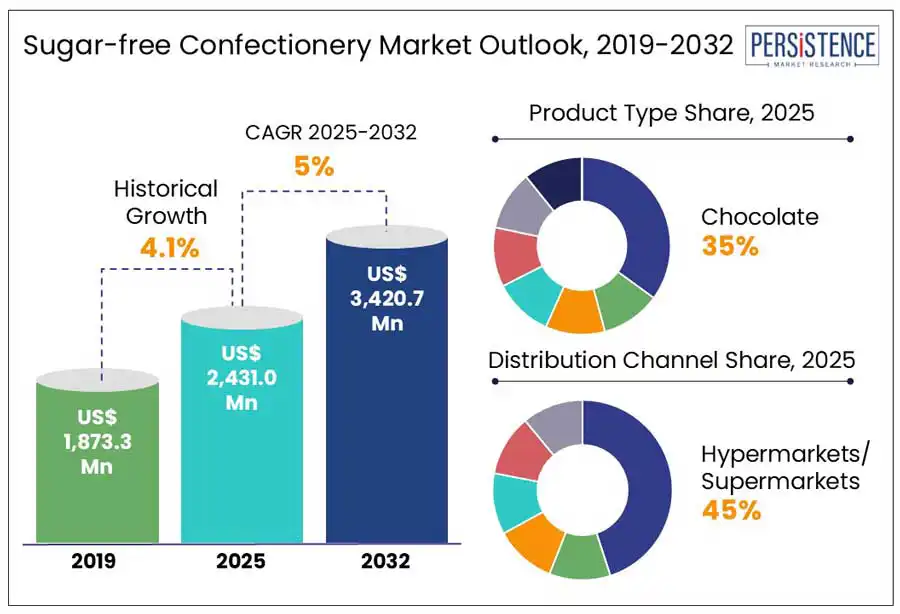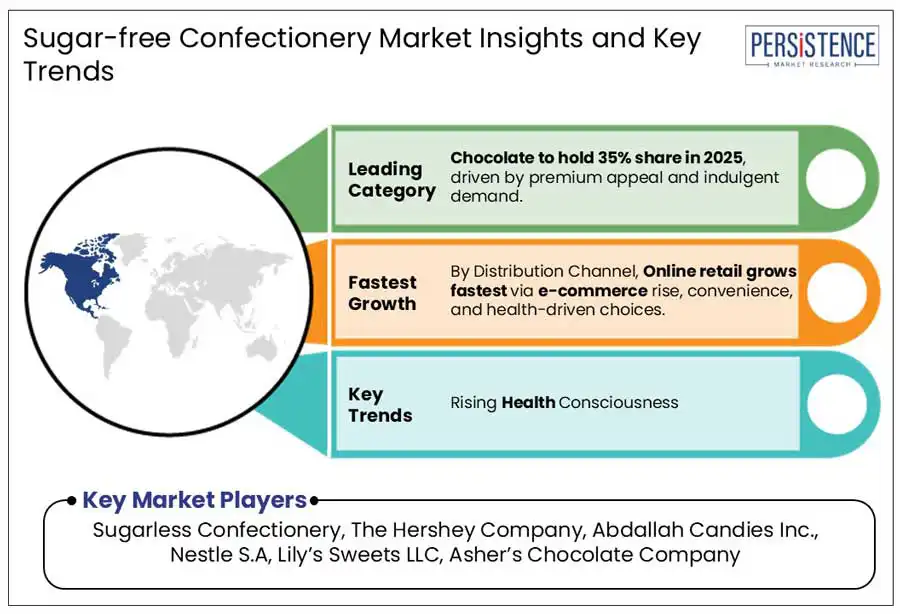Comprehensive Analysis of Sugar-free Confectionery Market Report, Including Regional and Country Analysis in Brief.
Industry: Food and Beverages
Published Date: April-2025
Format: PPT*, PDF, EXCEL
Delivery Timelines: Contact Sales
Number of Pages: 130
Report ID: PMRREP32931
The global sugar-free confectionery market size is anticipated to reach a value of US$ 2,431.0 Mn in 2025 and is set to witness a CAGR of 5.0% from 2025 to 2032. The market will likely attain a value of US$ 3,420.7 Mn in 2032. According to the Persistence Market Research report, rising health awareness, prevalence of diabetes, and demand for low-calorie treats, encourages the need for sugar-free confectionery products. The use of natural sweeteners, functional ingredients, and sustainable packaging, along with clean-label trends is driving its popularity across both developed and emerging markets.

Key Industry Highlights:
|
Global Market Attribute |
Key Insights |
|
Sugar-free Confectionery Market Size (2025E) |
US$ 2,431.0 Mn |
|
Market Value Forecast (2032F) |
US$ 3,420.7 Mn |
|
Projected Growth (CAGR 2025 to 2032) |
5.0% |
|
Historical Market Growth (CAGR 2019 to 2024) |
4.1% |
The rising preference for natural, low-calorie sweeteners is significantly boosting the sugar-free confectionery market. Stevia, a plant-based sweetener that is many times sweeter than table sugar, offers health benefits such as supporting weight management and helping regulate blood sugar and cholesterol levels. It is widely used in confectionery products as a sugar substitute, particularly among health-conscious consumers and individuals with type-2 diabetes. Additionally, reducing added sugar intake is becoming a key concern for parents, as the American Heart Association (AHA) highlights that high sugar consumption in children increases the risk of heart disease and obesity.
Taste and texture challenges remain a key restraint in the sugar-free confectionery market, as consumers often expect the same indulgent experience as traditional sweets. While sugar alternatives such as stevia and erythritol offer health benefits, they produce aftertastes or cooling effects that differ significantly from sugar. A 2022 survey by the International Food Information Council (IFIC) found that 53% of consumers cited taste as the most important factor when choosing snacks, outweighing health or calorie content. Furthermore, over 40% of respondents expressed concerns about the taste quality of sugar-free products. These preferences highlight the need for ongoing formulation advancements to match the sensory appeal of sugar-based confectionery.
Growing consumer demand for reduced sugar intake is fostering stable growth for both artificial and natural sweeteners. Manufacturers are adopting varied strategies based on product type and customer needs, launching inherently fewer sweet products and innovating with sugar substitutes such as stevia and monk fruit.
The shift toward healthier and more sustainable lifestyles is also pushing confectionery producers to focus on clean-label, no-added-sugar claims. These developments present strong opportunities for market expansion. For example, Lily’s Sweets offers no-added-sugar confectionery using stevia, reflecting how product innovation is aligned with evolving consumer preferences.
Chocolates are leading the sugar-free confectionery market due to their wide consumer appeal and versatility in sugar-free formulations. Unlike other sweets, chocolates can be easily adapted using natural sweeteners like stevia or monk fruit without compromising taste or texture. Their indulgent nature, combined with growing health awareness, makes them an ideal choice for consumers seeking guilt-free treats. Additionally, manufacturers continue to innovate with flavors, ingredients, and clean-label options, further boosting the popularity of sugar-free chocolates in both mainstream and niche health-conscious segments.
Hypermarkets and supermarkets are leading as the primary distribution channels in the sugar-free confectionery market due to their wide consumer reach, product variety, and convenience. These large-format stores allow customers to easily compare sugar-free options, read labels, and make informed choices, crucial for health-conscious buyers. They also support impulse purchases through attractive in-store displays and promotions. A recent shopper behavior survey revealed that nearly 65% of consumers prefer purchasing confectionery products in physical retail stores due to immediate product access and perceived reliability. This strong in-store presence and trust make hypermarkets and supermarkets the dominant sales channel.

North America leads the sugar-free confectionery market due to high health awareness, widespread diabetes and obesity concerns, and strong purchasing power. Consumers in the region actively seek low-sugar or sugar-free alternatives as part of healthier lifestyles. The U.S. is one of the high-ranking countries for diabetes estimating over 11% of the population is diagnosed, fueling demand for sugar-free products, according to the CDC. Additionally, North American consumers are more receptive to innovations in natural sweeteners and clean-label products. With strong retail infrastructure and the popularity of functional snacks, the region continues to dominate the market in both consumption and product innovation.
?Europe is one of the most significant regions in the sugar-free confectionery market due to the rising health consciousness, strong regulatory backing for reduced sugar intake, and growing demand for clean-label and diabetic-friendly products. Many European countries have implemented sugar taxes and national strategies to reduce sugar consumption, prompting consumers to seek healthier alternatives. According to WHO Europe, average sugar consumption in several European nations still exceeds the recommended 10% of total energy intake, driving reformulation efforts. European consumers place strong emphasis on transparency and ingredient quality, motivating manufacturers to develop products using natural sweeteners such as stevia and monk fruit.
?East Asia is expected to witness fast-growth in the sugar-free confectionery market due to the rising health awareness, increasing lifestyle-related diseases, and rapid urbanization. The region has witnessed a significant rise in diabetes, with India and China together accounting for over 200 million diabetic individuals, fueling demand for sugar alternatives. Additionally, obesity rates are climbing across East Asia due to sedentary lifestyles and high-sugar diets, prompting consumers to shift toward healthier snacks, including sugar-free candies and gums. Urban middle-class growth and improved access to health-focused products via supermarkets and e-commerce platforms are accelerating this trend, particularly among younger, health-conscious consumers.
The global sugar-free confectionery market is competitive. Increasing research & development activities and product innovation to fulfill the demand for consumers seeking sugar-free confectionery across the global markets. With the utilization of state-of-the-art manufacturing techniques, the players are providing a holistic solution in regards with sugar-free confectionery. The manufacturers of sugar-free confectionery are further investing in the expansion of production facilities and processing technologies in order to increase their operational efficiency.
|
Report Attribute |
Details |
|
Historical Data/Actuals |
2019 - 2024 |
|
Forecast Period |
2025 - 2032 |
|
Market Analysis Units |
Value: US$ Mn, Volume: As applicable |
|
Geographical Coverage |
|
|
Segmental Coverage |
|
|
Competitive Analysis |
|
|
Report Highlights |
|
|
Customization and Pricing |
Available upon request |
By Type
By Distribution Channel
By Region
To know more about delivery timeline for this report Contact Sales

The global market is estimated to increase from US$ 2,431.0 Mn in 2025 to US$ 3,420.7 Mn in 2032.
Rising health awareness, diabetes prevalence, demand for low-calorie treats, and innovations in natural sweeteners drive the sugar-free confectionery market.
The market is projected to record a CAGR of 5.0% during the forecast period from 2025 to 2032.
Opportunities include product innovation, clean-label demand, natural sweeteners adoption, expanding diabetic population, and growing interest in healthier snacking options globally.
Major players include Sugarless Confectionery, The Hershey Company, Abdallah Candies Inc., Nestle S.A, Lily’s Sweets LLC, Asher’s Chocolate Company, and Others.